An estimated 170,000 million gallons of water was withdrawn from the ground, lakes, or
streams each day on the 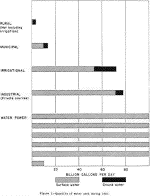 average during 1950 and used on the farms and in the homes,
factories, and business establishments of the United States. An additional 1,100,000
million gallons per day was used to generate hydro-power. Water power is the largest
user of water; however, irrigation and industry also are large users of both ground and
surface water. More surface water was used for industrial purposes than for irrigation,
whereas more ground water was used for irrigation than for industrial purposes (fig. 1).
The total withdrawal of surface water was considerably in excess of ground-water
withdrawal, as shown by figure 1. Large quantities of water were used also for purposes
requiring no diversion, such as navigation, waste disposal, recreation, and support of
wildlife.
average during 1950 and used on the farms and in the homes,
factories, and business establishments of the United States. An additional 1,100,000
million gallons per day was used to generate hydro-power. Water power is the largest
user of water; however, irrigation and industry also are large users of both ground and
surface water. More surface water was used for industrial purposes than for irrigation,
whereas more ground water was used for irrigation than for industrial purposes (fig. 1).
The total withdrawal of surface water was considerably in excess of ground-water
withdrawal, as shown by figure 1. Large quantities of water were used also for purposes
requiring no diversion, such as navigation, waste disposal, recreation, and support of
wildlife.
Knowledge of quantity and distribution of withdrawals is an essential part of any water-resources study. However, very few attempts have been made to estimate the total quantity of water withdrawn for use in the United States. Some investigators have made inventories or estimates for a single type of use. The U.S. Public Health Service (1945), in cooperation with the sanitary-engineering divisions of state health departments, makes an annual inventory of public water-supply systems, which includes the quantity of water used. Guyton (1950) made an estimate of ground water used in the United States during 1945. Langbein (1950), made an estimate of the quantity of water used in the United States during 1946 for generation of hydroelectric power.
This report presents a preliminary estimate of the quantity of water withdrawn during 1950 from ground and surface sources. Some water was withdrawn from a source, used, and discharged into a stream or the ground, only to be withdrawn again. Each time the water was taken from the natural source it was added to the accumulated totals of water withdrawn; therefore, some of the water has been counted several times. However, if water was withdrawn and recirculated, so that it was used several times in the same plant before it was discharged into a stream or the ground, it was counted only once. Although based on the best information available, the estimates in this report are, in general, rough approximations of the quantity of water used. The estimate for municipal use is probably the most accurate and that for industrial surface water use the least accurate. It is intended that these figures be used as estimates only.
The compilation was prepared in the Water Resources Division of the U. S. Geological Survey by Kenneth A. MacKichan under the technical and administrative supervision of R. W. Davenport, Chief, Technical Coordination Branch, and with the advice of W. F. Guyton, ground-water hydrologist.
The U. S. Public Health Service furnished estimates of the quantity of water used for municipal supplies in many of the states. These estimates were based on the unpublished 1948 inventory of water and sewage facilities. The Illinois estimates for municipal use of ground water and for industrial use of both surface and ground water from private sources were furnished by the Illinois State Water Survey.
The quantity of water used for any purpose is affected by many factors, the most important of which are availability, temperature and quality of the supply, and waste in the use of water.
Water may be used generously if a large supply of water is available. For example, if an irrigator has plenty of water he will apply more than the minimum required for his crop in the expectation of reaping an increased harvest. This is an advantage to him, although the additional water would produce more if it could be applied to additional land. If a manufacturer has an inadequate supply he can often reclaim and reuse much of his process water, although if sufficient water were available it would be better to withdraw unused water. Cooling water also can be reclaimed by the use of cooling towers, but this is usually more expensive than withdrawing additional unused water.
Waste is of two types, temporary and permanent. Temporary waste returns to the ground or streams, where usually it is again available for use. Leaky plumbing is the cause of great waste of this kind. This is especially true in unmetered areas because the householder does not pay in proportion to the amount of water used. An energetic program in Chicago for the elimination of leakage and waste in the public water-supply system reduced the use from 1,059.4 mgd in 1930 to 972.4 mgd in 1949, although the population served increased from 3,683,000 in 1930 to 4,118,119 in 1949 (DeBerard, 1950). This is a reduction in per-capita consumption from 288 gallons per day in 1939 to 234 gallons per day in 1949.
Water used by nonbeneficial evaporation or transpiration is not available for reuse; it is therefore permanently wasted. Phreatophytes are plants that depend almost entirely on the ground-water reservoir for their water supply. They usually grow along stream channels, canals, or reservoirs. Most phreatophytes are of no economic importance, therefore the large quantities of water that they use may be considered wasted. For example, it has been estimated (Gatewood, Robinson, Colby, Hem, and Halpenny, 1950) that about 28,000 acre-feet of water was used by bottom-land vegetation in the 46-mile reach of the Gila River between Thatcher and Calva during the 12-month period ending September 30, 1944. Part of the large quantity of water that is wasted by unnecessary evaporation from storage reservoirs could be saved if more were known about the physics of evaporation and if such knowledge were used in the design and operation of reservoirs.
Water is an efficient agent for the transfer of heat, and accordingly one of its largest uses is for cooling. Cooling involves the transfer of heat from a machine or product to the water. The amount of heat transferred is directly proportional to the increase in temperature. If water is to be discharged at a fixed temperature, the amount of heat absorbed will be greater if the temperature of the entering water is low, which in turn will require less water to carry away a given amount of heat.
The quality of the water often affects the quantity used. Sometimes poor quality encourages saving of water. If water as taken from the ground or a stream requires extensive treatment it may be more economical to reclaim and reuse waste water from the plant than to treat raw water and use it only once. The additional expense of treating the water will encourage water-saving practices. On the other hand larger quantities of water are required for irrigation if the water contains dissolved salts. Additional water is required to flush accumulated salts from the soil, thus preventing the soil from becoming alkalized.
Uses of water may be classified in several different ways. Among them are withdrawal and nonwithdrawal uses and consumptive and nonconsumptive uses. Withdrawal uses require that the water be removed from the ground or diverted from a stream or lake. Irrigation, water power, and domestic, municipal, and industrial uses are of this type. Nonwithdrawal uses do not require diversion. Navigation, recreation, waste disposal, and conservation of wildlife are examples of nonwithdrawal uses.
Water is used consumptively when it is incorporated into a product or is evaporated. It is difficult to classify uses as entirely consumptive or nonconsumptive because in most uses only part of the water is consumed. Irrigation is considered a consumptive use although 20 to 60 percent of the water may seep into a stream as return flow. Much of the water used from public supplies may flow into the streams as sewage effluent. Most nonwithdrawal uses are nonconsumptive, although a large quantity of water is evaporated from bodies of water provided for these uses. For example, evaporation from reservoirs and ponds in North Dakota is estimated to average 170 million gallons per day. This is almost equal to all withdrawal uses in the State. Cooling is usually considered a nonconsumptive use, although a considerable portion of the water may be evaporated.
Uses have been classified as withdrawal or nonwithdrawal for the purpose of this report.
Withdrawal uses lend themselves to evaluation in terms of quantity, as they require the
water to be removed from the ground, stream, lake, or pond. The important withdrawal
uses are (l) municipal, (2) rural, domestic, and stock, (3) irrigation, (4) industrial, and (5)
water power. An estimate of withdrawal use in the United States during 1950 is given in
table 1 and is shown graphically in figures 2 to 6. The estimates are for the five types of
uses by States and by source of supply, ground water or surface water.
Municipal water systems served 93.5 million people in 1950, an average of 145 gallons per day per person or a total of 13,600 million gallons per day. Water for municipal use includes all water pumped into the public-supply systems. This includes that used in fire protection, for flushing streets, by business establishments, and by some manufacturers, as well as for domestic purposes. Leakage also is included, because the water is measured at the source. Public-supply systems include both those publicly and those privately owned.
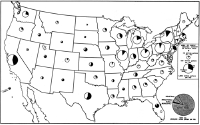 Most of the estimates of the water used by municipal water-supply systems were
furnished by the U. S. Public Health Service. The data were based on their 1948
inventory of water and sewage facilities in the United States. Data on the average daily
use were available for approximately 80 percent of the population served. The Public
Health Service estimated the daily use of the remaining 20 percent by developing a per-capita factor for each of eight population groups within each state for which both
population and use were known, and extrapolating this factor over the entire population
served within that group for that type of supply.
Most of the estimates of the water used by municipal water-supply systems were
furnished by the U. S. Public Health Service. The data were based on their 1948
inventory of water and sewage facilities in the United States. Data on the average daily
use were available for approximately 80 percent of the population served. The Public
Health Service estimated the daily use of the remaining 20 percent by developing a per-capita factor for each of eight population groups within each state for which both
population and use were known, and extrapolating this factor over the entire population
served within that group for that type of supply.
Both ground water and surface water were listed as the source of many supplies. The data were reviewed by the Public Health Service, and in many areas it was possible to assign the source to either ground water or surface water. Eight and one-half percent of the water used could not be definitely assigned to either classification. It was divided equally between ground-water and surface-water sources.
The rural population of the United States in 1950 was 57.5 million; (of this total 22 percent was served by running water) and used an estimted 3,500 million gallons of water per day. Water consumed by livestock and poultry and water used in all homes not served from a public supply is included in this estimate. The estimates for some of the states were made in the district office of the Geological Survey. The remainder were computed on the basis of census figures and estimated daily requirements. Estimates made in the district offices were checked against quantities computed on the basis of census figures.
 The
population used in computing the rural domestic use was estimated by subtracting
the population served by public water-supply systems from the total population. The
population served by public-supply systems was furnished by the U. S. Public Health
Service and was based on its 1948 inventory. The total population was taken from the
1950 census. The percentage of the rural population served by running water was
estimated to be equal to that of the farm population served by running water, and was
computed from the 1945 Census of Agriculture. The estimated quantity of water used by
those having and those not having running water was computed separately by allowing a
daily use of 10 gallons per capita for those without running water and 80 gallons per
capita for those with running water. The per-capita use of those with running water may
appear to be too high. However, it is believed that the total use shown is about correct,
because the population served by running water may have been estimated too low. Many
country homes built since the 1945 census have running water, and water systems have
been installed in many old country homes. Another reason that the estimate may be too
low is that it is based on the percentage of farm homes having running water, whereas the
percentage of rural nonfarm homes having running water probably is greater. In many
states the rural nonfarm population was equal to or greater than the farm population.
The
population used in computing the rural domestic use was estimated by subtracting
the population served by public water-supply systems from the total population. The
population served by public-supply systems was furnished by the U. S. Public Health
Service and was based on its 1948 inventory. The total population was taken from the
1950 census. The percentage of the rural population served by running water was
estimated to be equal to that of the farm population served by running water, and was
computed from the 1945 Census of Agriculture. The estimated quantity of water used by
those having and those not having running water was computed separately by allowing a
daily use of 10 gallons per capita for those without running water and 80 gallons per
capita for those with running water. The per-capita use of those with running water may
appear to be too high. However, it is believed that the total use shown is about correct,
because the population served by running water may have been estimated too low. Many
country homes built since the 1945 census have running water, and water systems have
been installed in many old country homes. Another reason that the estimate may be too
low is that it is based on the percentage of farm homes having running water, whereas the
percentage of rural nonfarm homes having running water probably is greater. In many
states the rural nonfarm population was equal to or greater than the farm population.
The quantity of water used by livestock was estimated on the basis of the livestock population taken from the 1945 agriculture census and the estimated per-capita use. Estimated average per-capita livestock use is as follows:
| Livestock |
Use (gal. per day) |
|---|---|
| Horses and mules | 10 |
| Cattle (except milk cows) | 10 |
| Milk cows | 15 |
| Chickens | .02 |
| Turkeys | .05 |
| Hogs | 4 |
| Sheep | 3 |
| Goats | 3 |
The division of rural domestic and stock water between ground-water and surface-water sources was rather difficult. For some states it is based on estimates made by the district office of the Geological Survey. For the remainder of the states, all domestic water and either three-fourths or one-half of the stock water, depending on the local water-resources conditions, was assumed to be from ground-water sources.
At least four bases might be used to measure the quantities of water required for irrigation. Consumptive use, which is the water transpired or evaporated from a cropped area, is one basis of measurement. A second basis is the water delivered to the farms. This includes consumptive use and seepage and evaporation from distribution ditches. A third basis is the water withdrawn from streams or the ground. In addition to that delivered to the farms this includes losses from the canals by evaporation, transpiration, seepage, and waste back to the stream. The fourth basis is the gross over-all supply. This would include evaporation and seepage from reservoirs, as well as diversions from the streams.
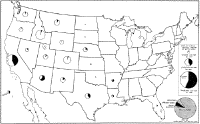 An estimated 100 million acre-feet of water was withdrawn in 1950 from the ground and
streams to irrigate 25 million acres. Of this quantity, 80 million acre-feet or 3.20 acre-feet
per acre was delivered to irrigators. In this report water delivered to irrigators has been
used as a measure of irrigation water. Most of the figures listed in table 1 were estimated
in the district offices of the Geological Survey. The remainder of the figures were
estimated by use of census data. The quantity of water delivered per acre irrigated was
computed from the 1939 census. The acreage irrigated was based on the 1945 census of
agriculture plus an estimated increase since 1945. In the 29 states not covered by the
irrigation census the quantity of water used for irrigation was estimated to be 0.5 acre-
foot per irrigated acre. The area irrigated was based on the 1945 census of agriculture
plus an estimated increase since 1945. The quantity of water used equals the product of
acreage irrigated times the estimated quantity of water used per acre.
An estimated 100 million acre-feet of water was withdrawn in 1950 from the ground and
streams to irrigate 25 million acres. Of this quantity, 80 million acre-feet or 3.20 acre-feet
per acre was delivered to irrigators. In this report water delivered to irrigators has been
used as a measure of irrigation water. Most of the figures listed in table 1 were estimated
in the district offices of the Geological Survey. The remainder of the figures were
estimated by use of census data. The quantity of water delivered per acre irrigated was
computed from the 1939 census. The acreage irrigated was based on the 1945 census of
agriculture plus an estimated increase since 1945. In the 29 states not covered by the
irrigation census the quantity of water used for irrigation was estimated to be 0.5 acre-
foot per irrigated acre. The area irrigated was based on the 1945 census of agriculture
plus an estimated increase since 1945. The quantity of water used equals the product of
acreage irrigated times the estimated quantity of water used per acre.
Industrial Use from Private Sources
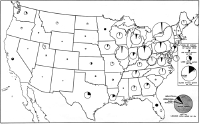 Water for industrial purposes as used in this report does not include water taken from
public water systems. The estimates given in table 1 were made in the various district
offices. Usually the estimates were based on a partial survey of industries and data on
manufacturing and business. Even though the use by some industries may have been
overestimated, the total for all industries probably tends to be too small because many
small industries remain unknown. However, the figures are probably about correct.
Water for industrial purposes as used in this report does not include water taken from
public water systems. The estimates given in table 1 were made in the various district
offices. Usually the estimates were based on a partial survey of industries and data on
manufacturing and business. Even though the use by some industries may have been
overestimated, the total for all industries probably tends to be too small because many
small industries remain unknown. However, the figures are probably about correct.
Brackish water has been included in the estimates of industrial use. It would be very
difficult to assign some of the water used to either brackish or fresh sources with any
degree of accuracy because it is from tidal streams, where the salinity may vary during
the year from nearly zero to that of sea water.
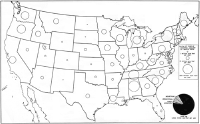 An
estimated 1,200 million acre-feet of water was withdrawn during 1950 for generation
of water power. The greater part of this water was used to generate electricity. However,
appreciable quantities of water were used to develop mechanical power to turn the
machinery in small factories and mills.
An
estimated 1,200 million acre-feet of water was withdrawn during 1950 for generation
of water power. The greater part of this water was used to generate electricity. However,
appreciable quantities of water were used to develop mechanical power to turn the
machinery in small factories and mills.
The quantity of water used was estimated from a tabulation furnished by the Federal Power Commission showing the net generation during 1946 for all hydroelectric plants in the United States. The plants were assumed to have an efficiency of 80 percent. The estimated quantity of water used in 1950 for all water power developed was then computed by multiplying the 1946 estimate by the ratio of (1) the estimated 1950 water power developed to (2) the 1946 hydroelectric power developed. The estimated 1950 water power developed includes both electric and mechanical power.
In contrast to withdrawal uses, nonwithdrawal uses do not lend themselves to evaluation
in terms of the quantity of water used. These uses do, however, have a very large
economic value. The most important nonwithdrawal uses are navigation, waste disposal,
recreation, and conservation of wildlife. Log driving was formerly important, but the
practice is falling into disuse.
Water-borne commerce is an important factor in our economy. In 1947 almost 22 billion short-ton miles of commerce was carried over our rivers (U. S. Dept. Army, 1947). This is exclusive of commerce carried on the coastal waterways. The following tabulation shows the tonnage carried during 1947 on the more important inland waterways (U. S. Dept. Commerce, 1949):
| Short tons |
|
|---|---|
| St. Marys' Falls Canal | 110,732,000 |
| Mississippi River | 51,427,000 |
| Ohio River | 41,397,000 |
| Monongahela River | 31,742,000 |
| Columbia and Lower Williamette Rivers | 15,938,000 |
| Hudson River | 10,849,000 |
| Illinois Waterway | 10,165,000 |
Streams have long been used to dilute and carry away waste. The capacity of a stream to
receive sewage and other organic wastes depends on the quantity of dissolved oxygen in
the water. The greater the flow the more dissolved oxygen the water carries and,
therefore, the larger the sewage load that can be safely handled. It is difficult to assign a
dollar value to the ability of streams to dispose of wastes. However, the kind and degree
of treatment—and its cost—required to control pollution by sewage and industrial waste is
dependent on the volume of water available in the receiving stream to dilute the entering
waste. For example, pulp and paper manufacturers on the Williamette River in Oregon
have been discharging their sulfite liquor waste products into the river. In July 1950 the
State Sanitary Authority ordered them to provide, by May 1, 1952, other means of
disposal of these wastes or to suspend operations during periods when the flow was less
than 7,000 cubic feet per second. At other plants liquid wastes are frequently stored
temporarily in ponds and allowed to discharge at a variable rate that depends on stream
flow. The discharge rate is set low enough that the oxygen in the stream can properly
handle the wastes and, therefore, treatment plants are not always required.
Recreation is becoming more and more important because people have more leisure time than formerly. Water sports, such as swimming, fishing, and boating, are a popular form of recreation. Obviously, the recreation value of water is important in coastal states or in states having a great number of natural lakes, where a sizable percentage of the tourist trade is attracted by water sports. However, water also has a great recreational value in many inland areas where reservoirs, formed by dams, are ideal recreational and vacation spots. For example, according to data furnished by the Iowa Conservation Commission, there are 73 natural lakes and 34 artificial lakes in the State. During 1949 the total attendance at lakes for which a count of users is available, was over 3-1/2 million people. The population of the State is about 2-1/2 millions.
According to the Tennessee Valley Authority there are an estimated 10,000 craft, ranging
from small fishing boats to cruisers, on the Tennessee River and its tributaries. It is
estimated also that the total count of visits to reservoirs in the basin may have been as
high as 10,000,000 person-days. According to the Tennessee Fish and Game
Commission, well over half a million fishing and hunting licenses were sold in 1949.
Conservation of wildlife is closely related to recreation, but it is important also to the
commercial fishing industry. For example, the salmon-canning industry in the Pacific
Northwest is entirely dependent on the spawning areas furnished by fresh-water streams.
Conservation of wildlife is important also in inland areas, such as the Tennessee Valley.
The Tennessee Fish and Game Commission estimates that 300,000 waterfowl (600,000
pounds) and 10,300,000 fish (11,000,000 pounds) were taken in 1949, the estimated value
of which, at 50 cents per pound, is $5,800,000.
Water use is divided into two general types, withdrawal and nonwithdrawal. The withdrawal uses can be evaluated in terms of quantity of water used. The estimated withdrawal use in the United States during 1950 is as follows:
| Use |
Million gallons per day |
|---|---|
| Water power | 1,100,000 |
| Rural (not including irrigation) | 3,600 |
| Municipal | 14,000 |
| Industrial (from private sources) | 77,000 |
| Irrigation | 79,000 |
Generation of water power is the largest use of water. Other uses total about 170,000 million gallons per day, which is 1,100 gallons per day for each man, woman, and child living the United States. The estimate is very rough and probably represents only a general approximation of the quantity used. In this estimate a considerable part of the water used was used several times and for several different uses. The quantity was counted each time it was used.
The principal nonwithdrawal uses are navigation, recreation, waste disposal, and
conservation of wildlife. Although these uses do not lend themselves to evaluation in
terms of quantity of water, they are of great economic importance.
DeBerard, W. W., 1950, Chicago water system serves growing population with decreased pumpage: Civil Eng., vol. 20, no. 11, pp. 699-703.
Gatewood, J. S., Robinson, T. W., Colby, B. R., Hen, J. D., Halpenny, L. C., 1950, Use of water by bottom-land vegetation in lower Safford Valley, Arizona: U. S. Geol. Survey Water-Supply Paper 1103, p. 203.
Guyton, W. F., 1950, Estimated use of ground water in the United States, 1945 (paper duplicated by the U. S. Geological Survey).
Langbein, W. B., 1950, An American survey: Water Power, vol. 2, no. 6, pp. 238-245, London, England.
U. S. Department of the Army, 1947, Annual Report of the Chief of Engineers, U. S. Army, pt. 2, pp. 24-27.
U. S. Department of Commerce, Bureau of the Census, 1949, Statistical Abstract of the United States.
U. S. Public Health Service, 1945, Inventory of water and sewage facilities in the United States.
For more information, contact: wu-info@usgs.gov